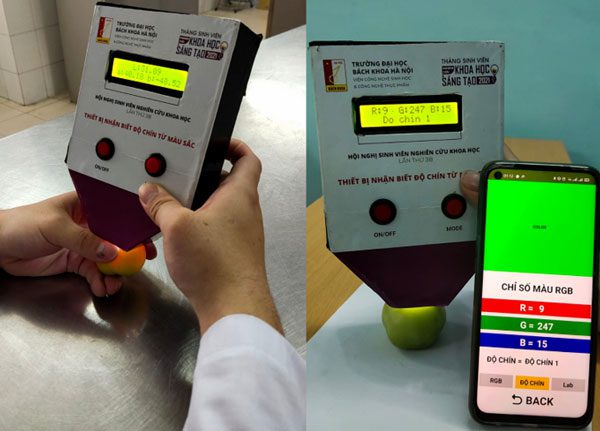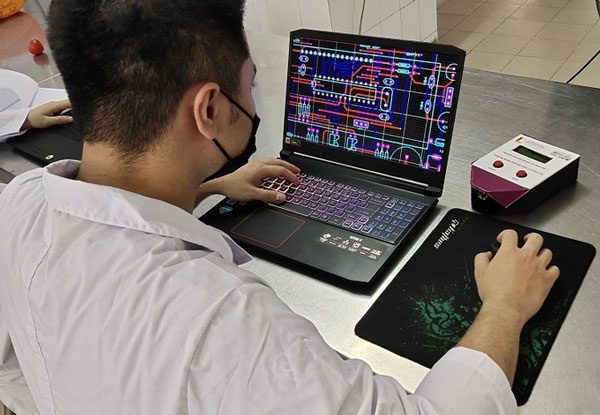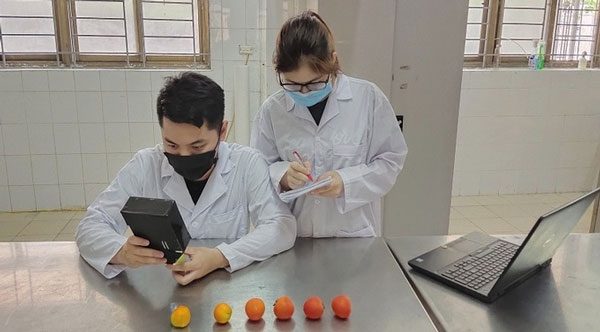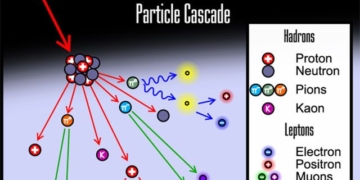The device developed by a group of students from Hanoi University of Science and Technology can connect to a mobile application to remotely monitor the ripeness of tomatoes.
At the scientific research competition held by the Institute of Biotechnology and Food Technology at Hanoi University of Science and Technology at the end of May, the device that identifies the ripeness of tomatoes, created by third-year students Nguyen Quang Anh, Pham Duy Tu, and Hoang Thien Nga, won first prize. The device can provide comprehensive information about ripeness and predict the time for harvesting ripe tomatoes.

The device measuring tomato ripeness connects to a mobile application for remote monitoring. Photo: NNC.
Quang Anh, a representative of the research team, stated that unripe tomatoes contain high levels of alkaloids that can cause nausea, fatigue, and poisoning. With the goal of ensuring health, the team created a portable device to help users more accurately determine the ripeness of tomatoes, allowing them to manage the timing of the harvest. They also aim to develop non-destructive analysis solutions for products.
The device is designed based on color sensors that measure corresponding color parameters. It is compact, about the size of a notebook, and integrates control modules and color sensors. Quang Anh mentioned that the team used two different color systems based on the human eye’s ability to perceive colors, enabling the device to observe unclear and difficult-to-distinguish colors on tomatoes, thus providing a more accurate assessment.
“Our team has identified six ripeness levels, corresponding to six different color parameter ranges, which we programmed into the microcontroller,” Tu explained. Users simply need to insert a tomato, and after 1-2 seconds, the color parameters and ripeness assessment are displayed on the device screen. The device has been successfully created, achieving an accuracy rate of over 90% in testing.

A research team member designing the microcontroller part of the device. Photo: NVCC.
Dr. Pham Ngoc Hung from the Institute of Biotechnology and Food Technology, who guided the research team, suggested the need for data that helps users store the long-term condition of the tomatoes. The team is continuing to design a mobile application that can connect to the measuring device.
More than 800 lines of code have been created by the team after three major adjustments to the programming structure, according to Thien Nga, who is responsible for designing and programming the application. Due to external lighting affecting the color parameter creation process, the team had to take multiple measurements with the sensor to produce a color parameter table that makes the device more flexible in recognition.
After more than a month of programming and design, the application can connect to the device via Bluetooth, providing comprehensive information about ripeness and predicting the time for harvesting ripe tomatoes. “In the near future, our team will upload this product to the CH Play app store for use and continue to improve it based on user feedback,” Nga said.
 The team adjusts color parameters suitable for application programming. Photo: NNC.
The team adjusts color parameters suitable for application programming. Photo: NNC.
Dr. Pham Ngoc Hung praised the spirit and research ideas of the team, which stem from real-life applications and a desire to implement them practically. “Your product can be used in teaching and research,” Dr. Hung stated. In addition to measuring tomato ripeness, the team is also working on integrating color measurement to assess the quality of food products during cultivation, processing, and storage.





















































